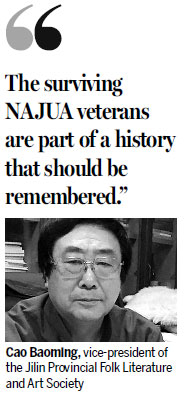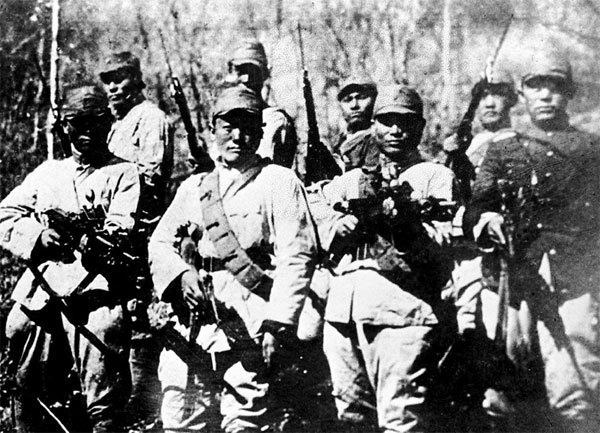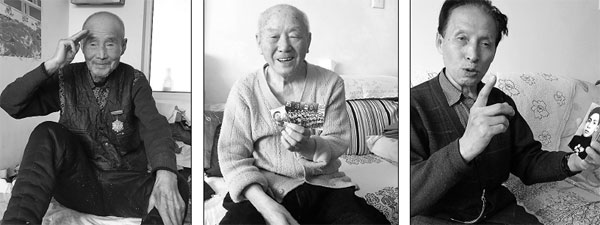China's forgotten army
Updated: 2015-05-27 07:32
By He Na, Liu Mingtai and Han Junhong(China Daily)
|
|||||||||||
During the Japanese occupation of Manchuria and also during World War II, a small, Communist-led guerrilla force was at the forefront of resistance in Northeast China. Now, that contribution is set to win the respect it deserves, as He Na, Liu Mingtai and Han Junhong report from Changchun.
Cao Baoming is desperate to record as many stories as possible about events in the Changbai Mountains more than 70 years ago, when the 1,300-kilometer-long range was the main theater of resistance to the Japanese occupation of China.
No one knows exactly how many Chinese soldiers died in the fierce fighting that encompassed the mountains that separate China, Russia and the Democratic People's Republic of Korea, but Cao is determined to discover as much as he can.
"So little has been recorded about NAJUA," said the vice-president of the Jilin Provincial Folk Literature and Art Society.
Cao was referring to the Northeast Anti-Japanese United Army, a communist-led guerrilla force that offered the largest resistance to Japan's occupation of northeastern China and the Manchukuo puppet regime it had established.
"Japan used northeast China as the supply base for its more-distant military excursions. Without the constant attacks by NAJUA that diverted its attention and strength, the Japanese army would have found it easier to turn its aggression on the rest of China," he said.
"The Japanese had worked out many ways to cut NAJUA's supply lines, but the guerrillas persevered and launched attacks that forced the Japanese to divert forces for punitive expeditions against them," he added.
However, to Cao's dismay, very few files and documents relate to this important part of Chinese history. "Apart from the stories of Yang Jingyu and several other NAJUA leaders, people rarely know the history, let alone the stories of those unknown soldiers," he said.
Cao spent the last Lunar New Year holiday at a private nursing home for old soldiers, and during his visit, he met a NAJUA veteran.
"I was absolutely moved by his stories, which were so real and new to me," he said. "Oral history is one of the few ways we can learn about this guerrilla army. The surviving NAJUA veterans are part of a history that should be remembered."
Recording history
At the end of March, the 66-year-old set up a project to record the veterans' stories, hoping to glean more information about NAJUA.
He was overjoyed when the Jilin Civil Affairs Department released the names of 271 veterans, but his mood darkened as more details came to light.
Between March and the end of April, 27 of the veterans died, and of the others more than half were in very poor health, paralyzed and unable to speak. A further 10 percent had moved to unknown locations.
"It's very worrying that so few of them have comparatively clear minds and can recall details accurately. It's a race against time because the youngest is 87 and the oldest is 98," Cao said.
More than 30 volunteers traveled far and wide to visit veterans and record their stories. So far, the stories of 50 veterans have been detailed.
"I'm really grateful to the volunteers, because they did the work in their own time and paid the expenses out of their own pockets," Cao said.
According to Wen Ye, historian and former curator of the NAJUA Museum in Harbin, capital of Heilongjiang province, the Japanese regarded the guerrillas as a cancer that greatly undermined their administration and derailed their military plans: "The important role NAJUA played in China's war against fascism made Manchukuo, the Japanese base, very unstable."
Wen said NAJUA's history can be divided into three phases: the Northeast anti-Japanese guerrillas: the Northeastern People's Revolutionary Army; and NAJUA.
Records at the Museum of Japanese Aggression in Changchun show that in 1934 all Communist Party units in the region were reorganized into a single force - the Northeast Anti-Japanese United Army, under the leadership of Zhao Shangzhi, an energetic graduate of the Whampoa Military Academy.
The following year, the guerrilla army was opened to anyone willing to fight, a move that won the support of students, farmers and even some local bandits.
By NAJUA's 1937 heyday, troop numbers had swollen to more than 30,000, and its sphere of action encompassed more than 70 counties across Northeast China.
Earlier this year, Cao traveled to Baishan in Jilin to visit Huang Dianjun, a veteran who had been close to Yang Jingyu, a NAJUA commander.
When Cao arrived, Huang was lying under a quilt on a kang (brick-made bed) with only his long white beard showing. The 93-year-old's eyes were bright and gleaming, but he lost the ability to speak several years ago.
Huang's son said his father had often spoken about the difficult wartime conditions.
"In addition to fighting the Japanese army's encirclement and suppression, the NAJUA soldiers also had to fight nature," he said.
"He told me that in summer, the biggest threats were poisonous snakes and insects such as mosquitoes. The moment you realized a snake was hissing toward you was really terrible. In winter they had to walk in snow almost a meter deep, and many soldiers froze to death because they didn't have warm clothes or shoes," he said.
According to Wen, to cut the supply lines, the Japanese mopped up villages with connections with NAJUA, and forced the residents to leave their homes and live in camps. They also created a strip of "No Man's Land" and committed more than 500 massacres.
Baijia Puzi, a village in Tonghua city that was a NAJUA stronghold, was the site of one of the worst atrocities. The Japanese attacked in July 1936, killing 412 villagers. Only three people survived.
Old scars never healed
Nowadays, Liu Zhenyu has just one hobby - watching TV programs about the Japanese occupation, although he once almost destroyed the TV after viewing a scene in which NAJUA soldiers were executed in cold blood.
"I have many scars left by the Japanese," the 90-year-old said, lifting his shirt to display the scars on his abdomen, stomach and back.
For Liu, every scar signals a narrow escape from death, such as the time he was shot in the neck.
"The bullet hit me when I was carrying explosives to bomb a Japanese stronghold," he said. "Our weapons were very poor, and bullets and guns were very precious. All of us had done a lot of bayonet practice," he said, showing a scar on his abdomen incurred during a bayonet fight.
Bai Qingchen, from Miaoling village in Fusong county, clenched his fists in rage as he described witnessing Japanese soldiers cutting the hearts out of dead Chinese troops before decapitating the corpses and hanging the severed heads from the branches of trees.
Bai joined NAJUA at age 18. "My first task was to deliver intelligence to three CPC members outside our town," he said.
The Japanese killed civilians randomly, so villagers avoided places where they might encounter the troops. However, on the day he carried the information, Bai was stopped by a detachment of Japanese soldiers.
"They were 50 meters away, so I quickly hid the intelligence in my left shoe," he said.
"Two Japanese holding guns came forward and asked who I was. The Japanese forced children in Manchukuo to learn their language, so I replied in Japanese and told them I was a student," he said.
Bai was searched, but the soldiers failed to find the messages he was carrying. "I tried to remain calm, but my heart was beating very fast. They told me to report to them if I heard anything about NAJUA. I told them I would, but inside I was smiling and thinking 'I'm the person you've been looking for!'" he said. Using his student cover identity, Bai successfully delivered many messages.
Revenge attacks
However, retribution was the order of the day, according to Wen: "Under the leadership of the CPC, NAJUA killed many Japanese and puppet army soldiers, so the Japanese carried out crazy acts of revenge that caused huge casualties to NAJUA, including several top leaders."
Bai witnessed one of the cruelest acts. "The Japanese killed commander Yang Jingyu in 1940. They put his head in a glass case and ordered four Chinese to parade it around the villages in our county. I couldn't helping crying when I saw his head with its square face and long beard," he said.
By 1940, only about 1,000 NAJUA troops were left, so they were evacuated to the Soviet Union to recover.
"Most of my comrades were killed. Very few survived," Bai said.
"I've outlived all of my former comrades. I have enough food and I sleep in a warm house in winter. I need nothing more," he said.
Cao believes the NAJUA troops were the unsung heroes of China's struggle against Japan, and their memory should be honored accordingly.
"Every time I say goodbye to one of these veterans, I worry that it may be our last meeting. These old men are heroes of our country. Now they are in the autumns of their lives, and they deserve the very best we can provide for them," he said.
Contact the writer at: hena@chinadaily.com.cn

|
The Northeast Anti-Japanese United Army, a communist-led guerrilla force, offered the largest resistance to Japan's occupation of northeastern China and the Manchukuo puppet regime it established in the area. Provided to China Daily |
|
From left to right) Liu Guowen, 89, Pan Fushun, 91, and Shen Delong, 92, are some of the surviving veterans of the Northeast Anti-Japanese United Army. The three old soldiers have provided historians with a huge amount of information, but many of their former comrades are in poor health and require 24-hour care. He Na / China Daily |
(China Daily 05/27/2015 page5)
Today's Top News
China issues first white paper on military strategy
China, Chile ink multi-billion-USD currency swap deal
China, Russia vow to boost cooperation
Chinese couple arrested in Lisbon on suspicion of money laundering
Premier Li arrives in Chile for official visit
Hou Hsiao-Hsien wins Best Director award at Cannes
Andrzej Duda wins presidential election in Poland
UK prime minister outlines who can vote in referendum
Hot Topics
Lunar probe , China growth forecasts, Emission rules get tougher, China seen through 'colored lens', International board,
Editor's Picks

|

|

|

|

|

|








